Native Plant Nursery Sales
Certified by the International Society of Arboriculture
30+ Years of Experience
Competitive Quality
Hours:
Request a Call Back
Hero Request Form
Thank you for contacting us.
We will get back to you as soon as possible
Please try again later
Native Plants and Trees for Landscaping
With modern arboriculture, it is possible to get trees from around the world. However, there’s something special about choosing a native species. At Woodlawn LLC, we can show you quality trees and plants that are native to our region. We’ll help you find the best options for your landscaping.
Woodlawn LLC trees are available in various root-size containers, starting with 10 gallons and ranging up to 280 gallons. Please note that not all trees are available in each size.
Browse the options below to see the native trees we carry. Do you see one you like? Call us now to learn more or get a free estimate from our certified arborist. With over 30 years of experience, we’re ready to help you find and plant the perfect trees!
Celebrate Local Trees
Call now for a free estimate on native trees from a certified, experienced arborist
(717) 254-4884
Reviews
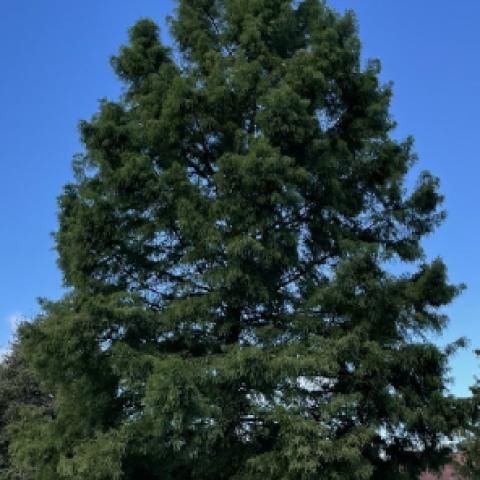
Bald Cypress
Taxodium Distichum
Although native to the southeast, this tree is hardy enough for northern Maine! The Bald Cypress, or Taxodium Distichum, grows in swamps and can thrive in year-round flooded areas, but it also survives in dry and compacted soils. Like the Dawn Redwood and Larches (it is in the same family as the Dawn Redwood), the Bald Cypress is a deciduous conifer, shedding its needles every autumn. The fall color is a pleasing orange, and the reddish to grayish brown bark contributes to winter interest. It grows 60 feet to 70 feet high and 25 feet to 30 feet wide.
Taxodium Distichum is a specimen tree with unique features, not the least of which are the protruding "knees" that grow around the tree in highly compacted or wet soils. These are areas, in fact, where few other tree varieties would thrive, much less grow additional features. The "knees" are very attractive, especially when combined with other landscaping features. Bald Cypress trees constitute an excellent choice for a deciduous conifer for parks or large lawns, especially those near bodies of water.
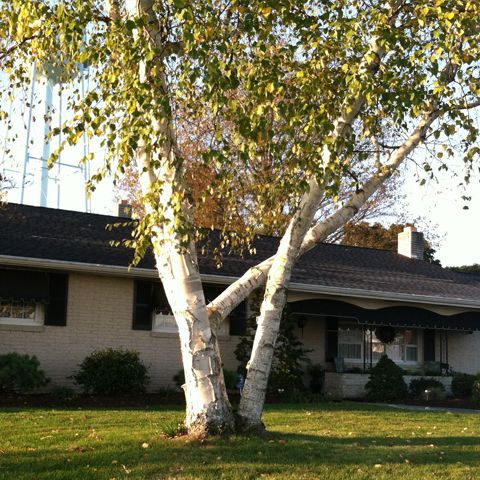
Birch
Betula
At Woodlawn LLC, we love Birches! Our favorite may be the Paper Birch. The bark is such a pure white, and the fall color such a rich yellow. Just imagine multi-stem groves in our northern hardwood forests! Unfortunately, we're simply too far south for Paper Birch to flourish.
There is good news, though! For those of us in the mid-Atlantic region, Betula still has much to offer. If you are dreaming about the white-barked Paper Birch, we can get you close with some of the cultivars of River Birch. "Heritage" is an old favorite, and some of the newer cultivars are even better. We currently have "Dura-Heat" River Birch which, in youth, has bark almost as white as Paper Birch. As the name suggests, this cultivar is very heat-tolerant, thriving as far south as Atlanta, GA! We have another River Birch cultivar called "City Slicker" in production. "City Slicker" is every bit as heat-tolerant as "Dura-Heat" with bark that is at least the same shade of white, if not even purer. As far as soil considerations, River Birch does well in all but the driest soil.
When we can look past our white-bark obsession, we'll notice a couple of other Birches worthy of consideration: Sweet Birch and Yellow Birch. These two Birches will outperform River Birch in dry locations, and Sweet Birch has phenomenal fall color and glossy copper stems in youth. Yellow Birch fall color is almost as stunning and the stems of young Yellow Birch can be a rich yellow-gold. Neither of these trees has any significant insect or disease problems.
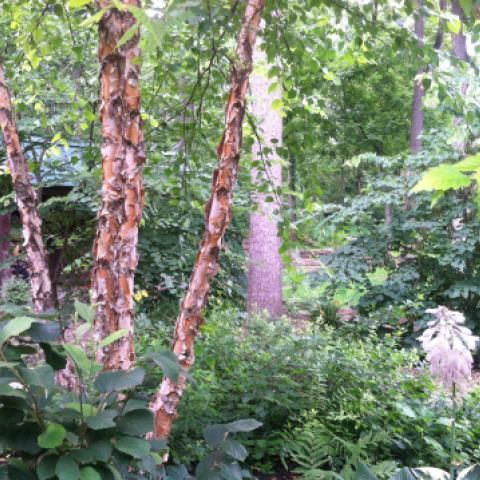
Birch (River) "City Slicker"
Betula Nigra "City Slicker"
The River Birch, or Betula Nigra, is a reliable, vigorous performer and one of the most adaptable and trouble-free members of the genus Birch. The River Birch "City Slicker" cultivar (Betula Nigra "City Slicker") has lighter bark and improved resistance to urban conditions.
River Birch is native to stream banks in the eastern deciduous forest. In the wild, it usually grows with multiple stems; however, single-stem specimens are less susceptible to breakage when mature. The cream-colored bark of the young tree ages to a pleasing scaly salmon color. Often planted without enough consideration for its rapid growth and potential large size, this tree usually reaches 50 feet in height with a 40-foot spread. The fall color is a respectable yellow. River Birch "Dura-Heat" is resistant to Bronze Birch Borers and Birch Leaf Miners, but it may become chlorotic in high pH soils.
One of our favorite companion plants for this tree is the Sweetbay, especially the "Moonglow" cultivar. The glossy, broad-leaf, semi-evergreen leaves of the Sweetbay enhance the year-round appeal of the River Birch bark. Consider plant shrubs with red and/or orange fall color beneath the River Birch to accent the bark and the fall shades. For a backdrop, use dark green conifers such as Oriental Spruce and Nordmann Fir.
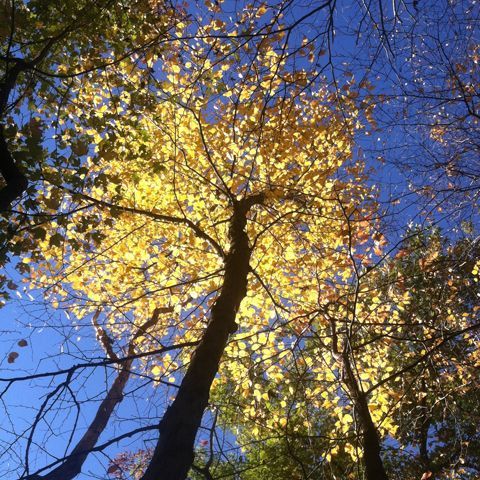
Birch (Sweet)
Betula Lenta
The Sweet Birch, or Betula Lenta, thrives high in the mountains often in dry, difficult conditions. Common in the wild, it is rarely offered in nurseries. People often focus on Birch trees with showy bark at the expense of the Sweet Birch. However, the rich summer foliage and golden fall color are reasons enough to invest in this fine tree. The Sweet Birch shows high resistance to Bronze Birch Borers and Birch Leaf Miners as well as tolerance for urban conditions and difficult growing sites. Also, the stems give off a pleasant wintergreen aroma when they are bruised as an interesting side note. Betula Lenta is also a long-lived tree with the oldest known specimen dated at 368 years old. It grows 40 feet or 50 feet high.
The Sweet Birch puts on an unrivaled fall show and should be planted where this can be fully enjoyed, such as among evergreens or other deciduous trees with orange and red fall color. A restful landscape scene often requires a mixture of both flamboyant and unassuming trees.
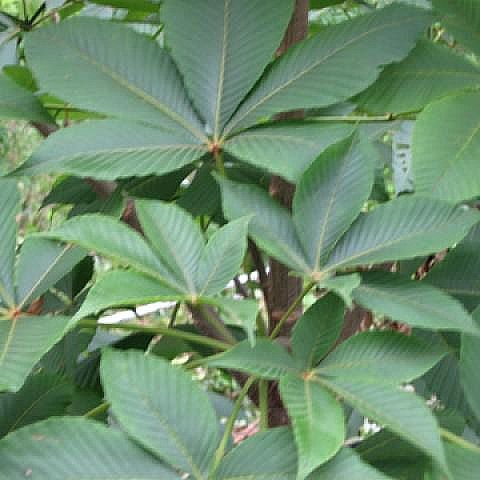
Buckeye (Yellow)
Aesculus Flava
The Yellow Buckeye, or Aesculus Flava, is a lovely, large shade tree with an upright-oval habit and several outstanding traits. The rich green foliage, with each leaf composed of five leaflets that are 4 inches to 6 inches long, is more disease-resistant than most other Buckeyes. The cream-colored flowers of early summer show up after most other plants have finished their floral displays. With irregular, gray-colored plates and bold texture, the bark remains interesting year-round. The largest of the native Buckeyes, Aesculus Flava is widely considered to be one of the most beautiful and trouble-free as well.
The Yellow Buckeye is a tree with an outspoken statement. While it can be placed in a grouping, the best use is as a specimen tree on the front lawn. Yellow Buckeye grows to about 80 feet high and 40 feet wide, and the bold framework forms a majestic silhouette during the dormant season.
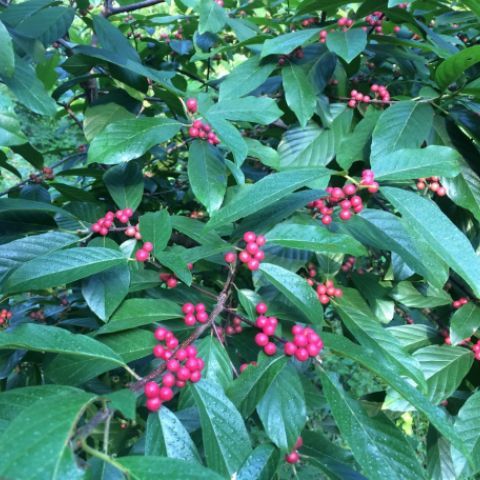
Cherry (Indian)
Frangula Caroliniana
What a fantastic plant is the Indian Cherry or Frangula Caroliniana! Lush foliage, striking late-summer fruit, and brilliant fall color are the ornamental features of this small native tree. The Indian Cherry tolerates difficult growing sites extremely well, and birds love the fruit. The flowers may be visually unremarkable, but you will know when the plant is in bloom! The area around the tree buzzes with activity as each pollinator rushes in for its share.
The Indian Cherry grows 10 to 15 feet tall with an equal spread. Excellent as a specimen anchoring small shrubs and perennials, Frangula Caroliniana should not be crowded with other plants of the same size. You do not want this one hidden in the landscape! Its shade tolerance also makes it useful in a woodland garden or as an understory tree. Plant it with the knowledge that you are contributing to a complex, beneficial biological community.
The Indian Cherry is also sometimes known as the Carolina Buckthorn because it was originally discovered in South Carolina.
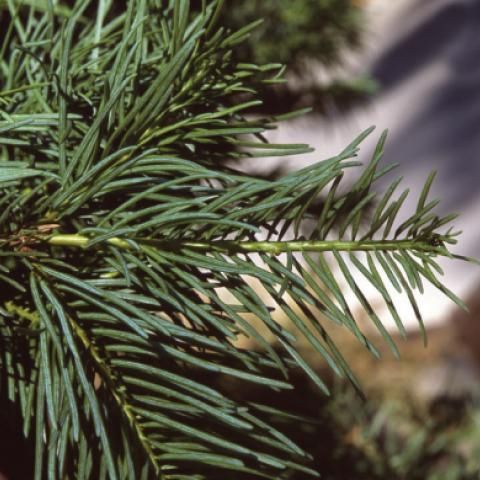
Fir (White)
Abies Concolor
Although native to the western United States, White Fir, or Abies Concolor, has also performed well in the east. The needles are 1.5 to 2.5 inches long, and the color varies from plant to plant. The color can range from light blue to medium green. The tree will reach 70 feet high and 25 feet wide. White Fir exhibits the distinctive Fir trait of the cones appearing upright on the branches, but an interesting note on the White Fir is that it might not produce cones or seeds for the first 40 years! White Fir is a hardy tree, tolerating dry and compacted soil. The habit is spire-shaped and narrow with tiered branches.
The popular Colorado Spruce (also known as Blue Spruce) has a similar outline and foliage color to the White Fir. Since we are seeing increased Cytospera infestations on the Colorado Spruce, we are recommending the White Fir as a superior substitute. Use as a specimen, in groupings, or for screening.
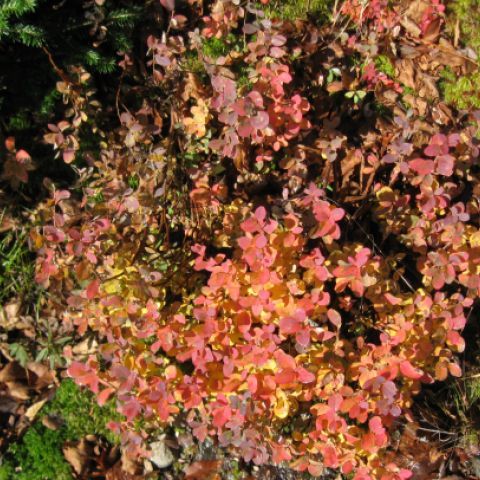
Fothergilla (Dwarf)
Fothergilla Gardennii
With Fothergilla, you get bottle-brush flowers in the spring and lush, disease-resistant summer foliage. The fall color is spectacular! The mature size is 4 to 5 high and wide. It tolerates a wide range of growing conditions but does best in moist soils and partially shaded environments.
Fothergilla is a versatile shrub and can be placed almost anywhere, although it is usually best planted in groupings. It is especially pleasing as an understory plant in a woodland garden. Too much shade, however, should be avoided, or Fothergilla will become leggy and open.
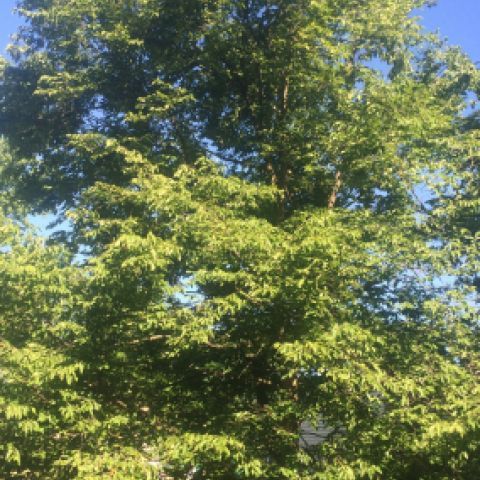
Hophornbeam (American)
Ostrya Virginiana
American Hophornbeam, or Ostrya Virginiana, is a small-sized to medium-sized native shade tree with flaking bark that blends perfectly with the medium-green foliage. The fall color is yellow. The bark and structure make a nice addition to the winter landscape.
Although a tough tree that will tolerate clay soil and drought well, American Hophornbeam may become tired and untidy-looking in late summer if growing conditions are difficult. This tree will blend nicely with most plants, and while not sensational in any season, it is always comfortably pleasing.
Hophornbeam grows to about 25 to 40 feet with a spread of 20 to 30 feet and can be used either as a specimen tree on the front lawn or as an accent plant at the corner of your house. It also makes a great understory tree in a naturalized situation. American Hophornbeam is also sometimes referred to as Ironwood due to its extremely hard, dense wood.
Hophornbeam is often used as a substitute for American Hornbeam, as Hophornbeam tolerates drought conditions better. Hophornbeam, however, does not tolerate wet soils. The habit of the Hophornbeam is more open than the American Hornbeam and is superior in summer. American Hornbeam's fall color, however, is more impressive.
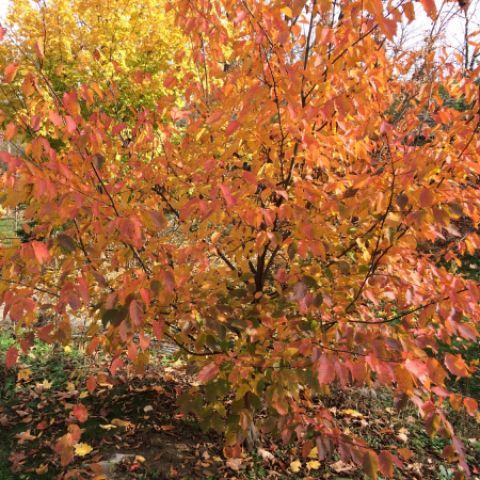
Hornbeam (American)
Carpinus Caroliniana
This tree has rich summer foliage with a dash of reddish new growth. Fall colors of yellow, orange, red, and burgundy. You’ll love the finely textured structure with a fluted trunk (which sometimes leads to its nickname of Musclewood) to add to the winter interest. All this describes the American Hornbeam, or Carpinus Caroliniana, a widespread understory tree growing 25 to 40 feet high. The American Hornbeam is native to the eastern United States deciduous forest. Small, dapper, and handsome, tolerating both full sun and part shade, this tree is also quite tolerant of compacted and clay soils. American Hornbeam also makes an excellent urban tree.
The American Hornbeam is a versatile tree that can be used as a specimen in the front lawn, as a corner accent plant, or as an understory tree in the backyard. American Hornbeam is resistant to Juglone and can be planted beneath Black Walnut. The leaves are marcescent, holding a warm tan into early winter.
The extremely hard wood of the American Hornbeam was once used by early Americans to make bowls, tool handles, and ox yokes. As the name suggests, the wood would take a horn-like polish.

Magnolia (Sweetbay) "Moonglow"
Magnolia Virginiana "Moonglow"
The lemon scent of the Sweetbay, or Magnolia Virginiana, blossoms on an early summer evening is like nothing else. The 2-inch to 3-inch, cream-colored flowers, while very attractive individually, would be visually overwhelming if they appeared in too large of numbers. Fortunately, they don't grow this way. Instead, the blooms appear a few at a time over a period of four to six weeks, giving us a lovely aroma that begins about the first of June and lasts well into July. As summer breezes stir the leaves, they expose the silvery undersides, adding to the soft, ornamental beauty of the plant. The red fruit appears in late summer. Sweetbay is very attractive even in winter!
Sweetbays are native to marshy areas of Appalachia and tolerate wet feet better than most Magnolias. Pest-resistant and disease-resistant, they are available in clump or single-stem plants and grow 10 to 35 feet tall. The leaves are deciduous in northern parts of the country but evergreen in the deep South.
Sweetbay can be used as a specimen, a corner accent, or an understory plant, but possibly the best use is to place it in the foreground of brick or stone masonry. Sweetbay also makes an almost perfect contrast plant for both broadleaf deciduous trees and evergreen conifers.
The genus name, Magnolia, honors Pierre Magnol, a French botanist who lived from 1638 to 1715, while the species - Virginiana - means “of Virginia.”
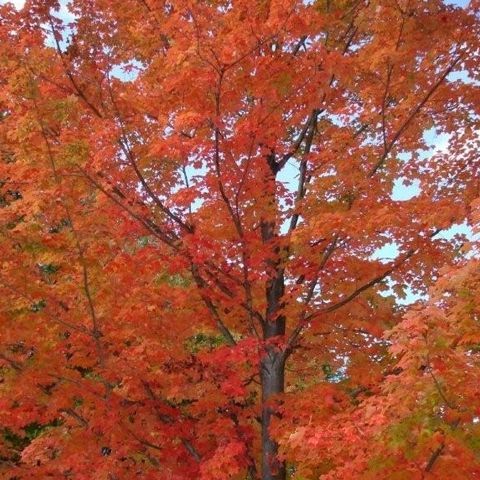
Maple (Red) "Sun Valley"
Acer Rubrum "Sun Valley"
Although the Red Maple trees, or Acer Rubrum, have red spring flowers, wonderful shade, and exceptional fall color, they are, as a species, an ornamental inferiority to the flaming Sugar Maple. The Red Maple does hold one trump card over the Sugar Maple, however. It tolerates urban conditions much better. Is there any way to have the best of both of these worlds? There is! The Red Maple cultivar “Sun Valley” has been selected for superior ornamental traits almost matching those of the Sugar Maple, while retaining the amenability to urban culture of the Red Maple. “Sun Valley” maple is a very desirable tree.
With its smaller leaves and lovely orange-red fall color, the spring flowers and fall color of “Sun Valley” are enhanced by blending it with evergreens. Pruning to develop structure is very important as this tree is prone to developing co-dominant stems. “Sun Valley” Maple grows 50 to 60 feet high and 30 to 40 feet wide and is tolerant of both wet and dry soils.
Please accept one word of caution. Red Maple trees are widely planted, sometimes to the point of creating monocultures. Choose another tree if you or your neighbors have 10% or more of this species. Since they are native to eastern North America from Quebec to Minnesota and south to Florida and eastern Texas, they are ubiquitous throughout much of North America.
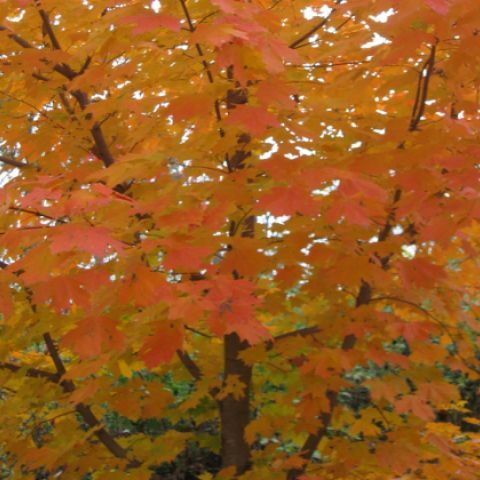
Maple (Rock, Sugar, Hard)
Acer Saccharum
A main component of the eastern hardwood forest in the United States, Sugar Maple, or Acer saccharum, is one of the trees most responsible for giving New England its reputation for spectacular fall color, and if the situational requirements can be met, it is one of the best large shade trees available. Soft, light-green flowers in the spring and rich, dark-green foliage in the summer, when combined with the grey, furrowed bark and winter structure, would be more than enough to place this tree high on any list of landscape trees. However, Sugar Maple unites all this with its unrivaled fall color of brilliant reds, oranges, and yellows. Sometimes you see all three on the same tree! Few other trees come close to it in the autumn season. Sugar Maple does need moist, well-drained soil and a pollution-free environment, however.
Acer Saccharum, growing 40 to 80 feet tall with a slightly smaller spread, will add to any location where it has the room to grow and contributes much to lawns, parks, golf courses, and campuses. It can serve as a specimen, be grouped with evergreens to enhance its autumn foliage effect (as if it needed enhancing), or stand outlined against the sunrise or sunset in the dormant season. The possibilities are endless.
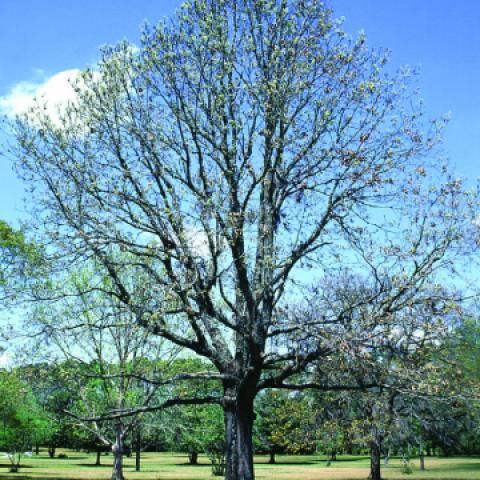
Oak (Black)
Quercus Velutina
A common tree in the Appalachian forests, Black Oak, or Quercus Velutina, is rarely found in nurseries and, unfortunately, is seldom planted. With its rich, glossy foliage, it is possibly the best shade tree in the Red Oak group. The bold, dark structure of the tree in the dormant season makes it a valuable addition to the winter landscape, especially after a snowfall. The bark is also interesting, featuring black with a blocky pattern. Its acorns are a food source for many birds and other wildlife. In fact, although it is a wonderful yard and park tree, its prolific acorn production sometimes precludes its use as a street tree due to the extensive cleanup required.
Black Oak is more tolerant than Red Oak to urban growing conditions and is also resistant to Oak Wilt and Bacterial Leaf Scorch. It will tolerate a variety of poor soils in the wild with dry, sandy, and heavy clay among them. It grows 60 to 80 feet high and 30 to 40 feet wide. Black Oak is primarily native to slopes, ridges, and upland hills from Florida to Texas. It can also be found north to Maine and west to Michigan and Minnesota.
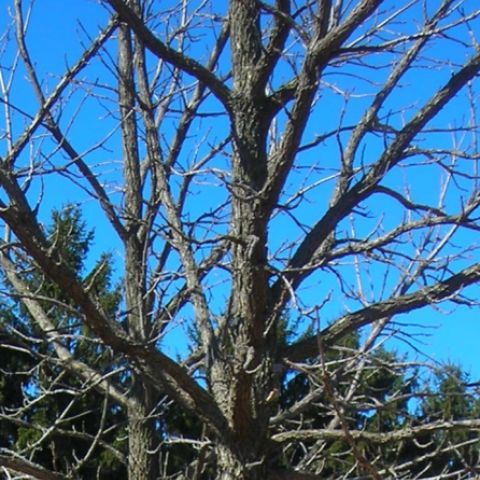
Oak (Burr)
Quercus Macrocarpa
Burr Oak, or Quercus Macrocarpa, one of the most majestic of our native oaks, is an adaptable tree with a rugged, cork-like bark texture that is especially noticeable when the tree is young. Summer foliage is a rich green, and fall color is a warm brown. The leaves are especially large. They can be 10 to 12 inches long! The winter outline is bold and open.
Burr Oak is a superb specimen tree, very tough and tolerant of both acidic and alkaline soils. It also handles either poorly drained or dry soils with relative ease and makes a fine urban tree if given enough space. Speaking of space, give it plenty. Quercus Macrocarpa can grow for centuries, reaching a height of 60 to 80 feet with a spread of equal size. This is one of those legacy trees. We plant them with the knowledge that our children and grandchildren will receive more benefits from them than we will.
That's perfectly okay. Tree planting is all about giving, not getting!
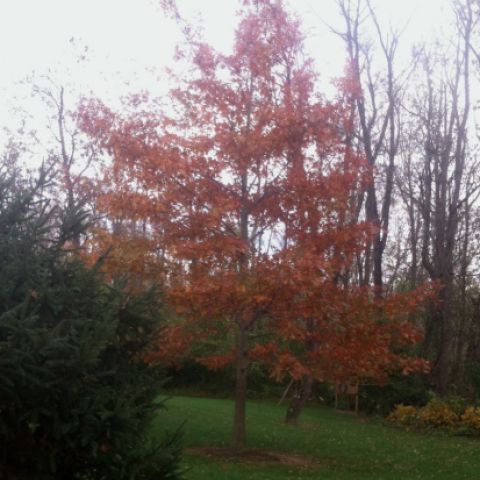
Oak (Nuttall)
Quercus Nuttallii
Nuttall Oak, or Quercus Nuttallii, a Pin Oak look-alike without the chlorosis problems, takes high pH soils in stride. In the spring, the new growth emerges reddish purple, changing to medium-green foliage during summer, and finally finishing out the season with excellent, orange-red fall color with a complete leaf drop as a bonus. The species is known for developing a full pyramidal canopy at an early age and rounding out as it grows older.
Nuttall Oak develops a good structure with a dominant central leader and usually reaches 50 to 80 feet tall with a slightly smaller spread. Oaks are often associated with slow growth, but not this one. Plan on at least 2 feet of growth per year and give your Quercus Nuttallii plenty of room. Nuttall Oak is tolerant of hot temperatures and urban conditions and makes an excellent shade tree. It can also be confidently planted as a specimen or street tree in parks, golf courses, and on campuses.
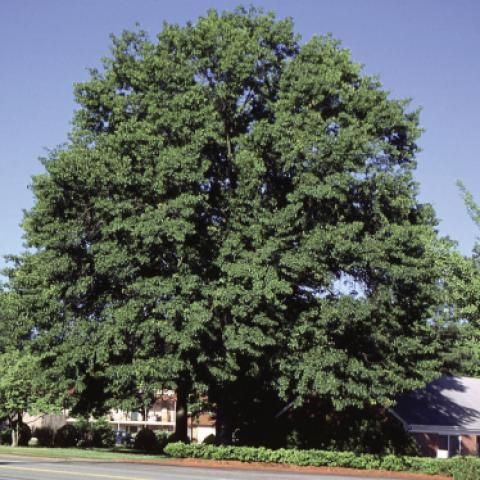
Oak (Red)
Quercus Rubra
Of all the Oaks, Red Oak, or Quercus Rubra, is the most distinguished for its bold, clean trunk and branches. The smooth bark, striated in long vertical sections, highlights the contrast between the smooth, raised surface and the darker-colored bark in between. This structure is especially handsome in the winter. Red Oak is a large tree, growing up to 70 feet or more with a spread of 50 to 70 feet.
The new growth in springtime is an interesting dusty, bronze-red hue that is almost as striking as the spring-flowering trees. In the fall, the Red Oak acorns are among the first acorns to ripen, making them an important early food source for wildlife. One interesting fact about Quercus Rubra is that it may not produce a full crop of acorns before reaching 40 years of age!
At Woodlawn LLC, we are becoming increasingly impressed with the performance and longevity of Red Oak. It doesn't like heavily compacted soil, but otherwise, it's a reliable urban performer. With its bold outline and clean trunk and branches, it makes an impressive silhouette against the sunrise or sunset.

Oak (Scarlet)
Quercus Coccinea
High in the mountains on dry, rocky ridges in obviously inhospitable growing conditions, the Scarlet Oak, or Quercus Coccinea, flourishes. Because of its lower lumber value, foresters consider it a second-rate species. In the landscape, however, it is one of our best Oaks as it thrives in difficult soils and challenging urban and suburban environments. Often misidentified as Pin Oak, Quercus Coccinea is much more tolerant of alkaline soils.
The foliage of the Scarlet Oak is a rich, dark, almost reflective green during the growing season and an outstanding scarlet red in the fall. This flaming autumn beauty often lasts three to four weeks. Similar in size to the other large native Oaks, Scarlet Oak matures in the landscape at about 70 feet high and 30 to 40 feet wide.
If Quercus Alba is the standard by which we measure all trees in the White Oak group, Quercus Coccinea ought to be the standard by which all trees in the Black Oak group are measured. Several close contenders do exist, but the brilliance of Scarlet Oak's fall color puts it ahead of the rest. Plant it as a specimen shade tree and enjoy its glory for years to come!
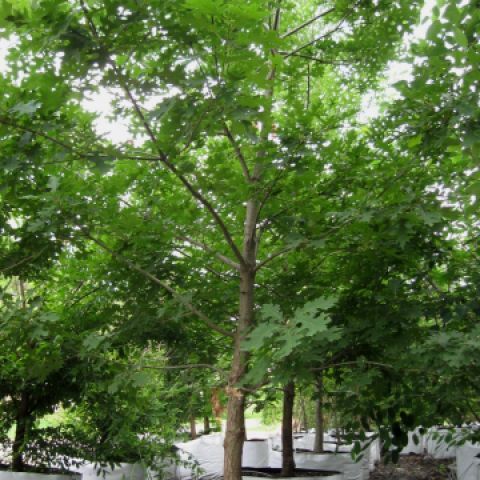
Oak (Shumard)
Quercus Shumardi
The Shumard Oak, or Quercus Shumardi, is an endangered species in the forests of Pennsylvania as only a few groves exist in Adams and Fulton counties. As an urban or suburban tree, Quercus Shumardi is much superior to the similar Pin Oak, as it tolerates high pH soils and adverse conditions much better. The Shumard Oak's fall color is also more reliable than the Pin Oak with orange, red, and burgundy appearing around the end of October. Size is comparable to most other large Oaks, reaching close to 70 feet with a slightly smaller spread. Pyramidal in youth, the canopy spreads to a broader, more open crown with age.
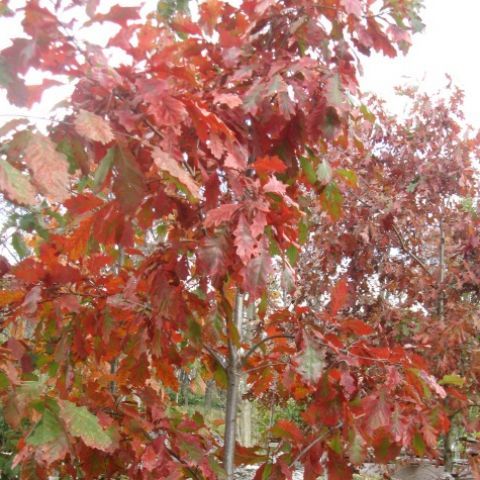
Oak (Swamp Chestnut)
Quercus Michauxii
The Chestnut Oaks are known for their tolerance of difficult locations, and the Quercus Michauxii is no exception, thriving especially in wet locations as its name suggests and tolerating even occasional flooding. This tree has the lightest-colored bark and the best fall color of all the Chestnut Oaks. Its leaves turn a deep, rich red, and this tree should find its place in more landscapes. An enormous tree, Swamp Chestnut Oak grows to about 70 or 100 feet high with a similar spread, and its growing range stretches from New Jersey to northern Florida, west to eastern Texas, and up the Mississippi River Valley to southern Illinois and Indiana.
The tree's species name comes from the French naturalist Francois Andre Michaux (1770-1855) who first described it. An interesting fact is that Swamp Chestnut acorns are often not produced until the tree reaches 20 to 25 years of age. These acorns were often consumed by livestock including cows, which led in years gone by to the common name of Cow Oak. Another common name, Basket Oak, was used because the wood was often split into thin but flexible strips for weaving heavy baskets used to harvest cotton from fields in the American South.
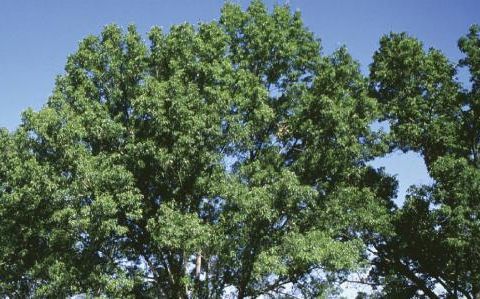
Oak (Swamp White)
Quercus Bicolor
If you want a bold, durable, and magnificent tree. Consider Swamp White Oak or Quercus Bicolor. This tree grows 50 to 60 feet tall with a spread of the same size, and it is a very similar tree to White Oak. They share the same aura of nobility with wide, spreading canopies of similar dimensions. Both are in the White Oak group.
There are a few differences. Swamp Oak bark is broken into smaller plates. Moreover, Swamp Oak tolerates compacted and wet soils better than White Oak, and it is easier to transplant than White Oak. Swamp Oak leaves are a darker green during the growing season. The leaves of the Swamp White Oak are shiny green on the top and silvery white on the bottom. That is the reason for the species name, Bicolor. Overall, Swamp Oak's fall color is inferior to White Oak's, but Swamp White Oak acorns are more likely to attract wildlife than White Oak's are.

Oak (White)
Quercus Alba
This is a truly grand tree! Noble, majestic, and durable both in appearance and in actual performance, we find this tree inspirational in all seasons. White Oak, or Quercus Alba, is never gaudy or flashy but is always solidly attractive. The structure, foliage, and bark color (all of its attributes in fact) come together to cause one to reflect on the majesty of God's handiwork. It easily ranks as one of America's greatest native trees.
The leaves are round-lobed, typical of trees in the White Oak group. The leaves open in the spring with pinkish hues that change to a soft, light green and finally mature into a rich, medium-dark green. The fall color is usually russet-red or burgundy. Young trees sometimes retain their foliage into the winter, but older trees almost always have clean leaf drop in the fall. The bark is broken into small vertically-arranged blocks or longer, scaly strips. The bark color is a light ashy grey that blends beautifully with the foliage at all stages of development. After the growing season has ended, the bark continues its appeal during the dormant season, blending its colors and textures with the solid structure and curves of the branches against the winter sky. White Oak is truly a four-season performer.
White Oak is also a patient tree. It takes an investment of time for White Oak to become the stately and noble tree we have just described. Today’s buying public too often has a short-sighted demand for instant gratification, but a mature White Oak is well worth the wait.
White Oak, however, does not tolerate change well. A new patio or driveway, an excavation to fix a water line, or simply soil compaction from people or equipment can wreak havoc on the root systems of many of our landscape trees, and White Oak is especially sensitive to these things. A small construction project can be the beginning of the end for an otherwise healthy Quercus Alba tree.
As with any other endeavor, successful White Oak culture simply means working within the limitations. Success in placing this fantastic tree in your landscape can be accomplished with a few common-sense guidelines, as follows:
- Be sure you have a suitable soil environment. While not overly hard to please, White Oak will not tolerate extremely poor soil. Do not attempt to place this tree in poorly drained or severely compacted traffic areas as described above. If growing conditions are marginal, you may want to substitute a Burr Oak or Swamp Chestnut Oak instead.
- Be certain the area has enough room for White Oak to reach its mature size of 50 to 80 feet with an equal spread.
- Think ahead. White Oak should be planted where it can grow undisturbed for centuries. Place the tree in a location not likely to be disturbed by any future construction or excavation.
- Purchase trees that have been propagated and grown in root-pruning containers. Trees grown by conventional methods are off to a very slow start at best. Root-pruning containers are designed to create a fibrous root system, and if properly installed and cared for, a root-pruned tree will establish itself very quickly with little to no transplant shock.
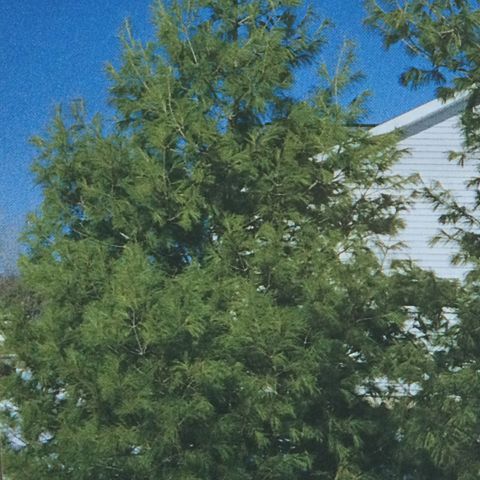
Pine (White)
Pinus Strobus
White Pine, or Pinus Strobus, is soft and plumy in youth and irregular and majestic in old age. Either way, it’s always attractive. Even young White Pines have the gift of appearing full and dense without appearing nearly as stiff or rigid as a Scotch or Austrian Pine. However, since it is a fast-growing tree with a tendency to shed limbs under ice and snow loads, White Pine is not a tree for restricted locations. Use with the knowledge that cleanup of broken, snow-damaged limbs will be a necessary task every spring after the tree reaches mature age. White Pine needles occur in bunches of five and persist for 18 months before abscising. White Pine grows 50 to 80 feet tall with a spread of 20 to 40 feet. Pine Tip Weevil can become a serious problem for young White Pines, killing the terminal bud and causing the tree to become flat-topped and crooked, but this problem can be controlled.
A very worthy tree for the right locations, it is native to the northeastern United States and Canada and is the state tree of both Maine and Michigan. In the 18th and 19th centuries especially, it was a highly regarded timber tree and is still valued for its lightweight, straight-grained wood (orange Heartwood and white Sapwood).
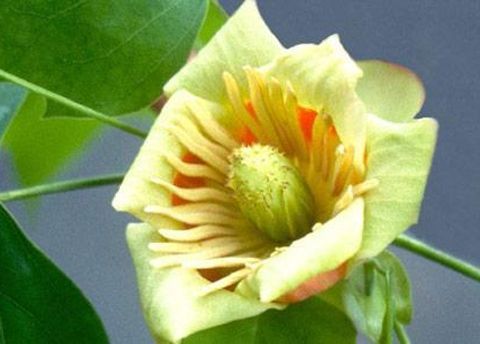
Poplar (Tulip)
Liriodendron Tulipifera
Everything about the Tulip Poplar, or Liriodendron Tulipifera, is big: the leaves, the bold branches, and the tree itself. Possibly the largest trees in the Eastern United States deciduous forest, Tulip Poplar trees are beautiful in youth and grand in old age as the uniformly spaced branches give a full, dense appearance at all life stages. The flowers are attractive, although some people will miss them since they are so far above their heads.
The fall color of the Liriodendron Tulipifera is a pleasant golden yellow. Mature height is usually 60 to 90 feet with a spread of 30 to 50 feet, although many trees grow even taller. The lack of lower branching gives Tulip Poplar trees of all sizes a stately, column-like appearance. Tulip Poplar is the state tree of Indiana, Tennessee, and Kentucky.
Use this tree as a shade tree or specimen. It can also be used in groupings. A grove of Tulip Poplar trees is extremely majestic. For maximum enjoyment of the unmistakable silhouette, place the trees where the outlines are visible above the skyline.
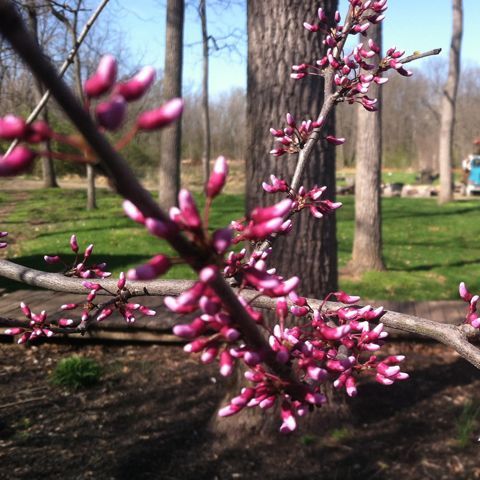
Redbud
Cercis
With a Redbud, the foliage is attractive during the growing season, the yellow fall color can be quite nice, and the reddish bark adds to the ornamental appeal during the dormant season. However, without question, spring is the high point for the Eastern Redbud. Brilliant, purple-pink flowers in profusion create a party atmosphere that begins in early to mid-April and persists for as long as four weeks.
The name Redbud is a misnomer. Neither the buds nor the flowers are red.
In the last 10 years, the cultivars have multiplied. Weeping forms and cultivars with foliage sporting shades of purple, yellow, orange, and variegated white have taken the market by storm. They can't even leave the flowers alone. There's a cultivar with white flowers. (What do you call that? A Whitebud?) While some of these forms are exciting and eye-catching in the formal landscape, the species is a great tree that may blend more naturally in the garden.
At Woodlawn LLC, we also grow “Avondale,” which is a cultivar of the Chinese Redbud. Chinese Redbud is even more gaudy than our native Redbud with rich pink flowers in profusion, covering not only the ends of the branches but also the stems.
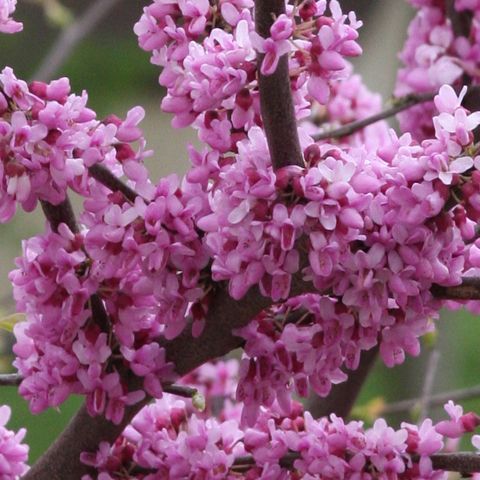
Redbud (Eastern)
Cercis Canadensis
Enjoy the yellow fall color, the ornamental bark, and the attractive, heart-shaped leaves, but save the drum roll for the spring show of the Eastern Redbud or Cercis canadensis! This beautiful pink display can last as long as three weeks in April, and you will want ringside seats. It is spectacular!
Somewhat surprisingly, this plant has neither red buds nor flowers. Stem Canker can occasionally be a problem with the Eastern Redbud. It also tends to be short-lived, usually not living much beyond 30 years. Eastern Redbud grows to about 20 feet high with equal or greater spread under a crown that can be either flat or rounded. Use as a specimen, in small groupings, or as a street tree. The point of an Eastern Redbud is display! For that, it truly has no competitor or equal and will provide enjoyment whether gracing a front lawn in the South or beautifying a roadway in Maine.
The Eastern Redbud is native to eastern and central North America from southern Ontario and the Great Lakes, south to Western Texas and Florida. Plant one today and enjoy!
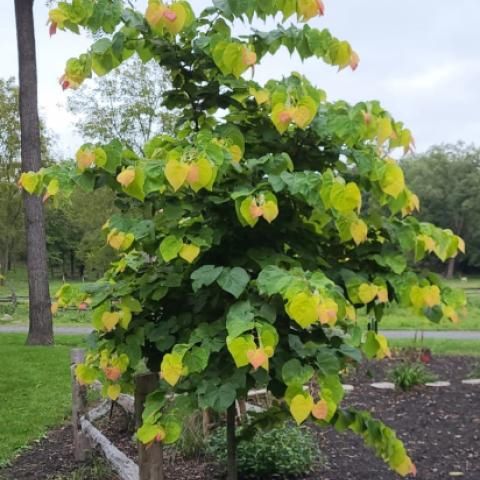
Redbud "Rising Sun"
Cercis Canadensis "Rising Sun"
A tree's foliage can seldom give its flowers a run for their money, especially not when the Eastern Redbud is in focus. However, the leaves on the Redbud “Rising Sun” manage to do exactly that. As the flowers begin to wane, the foliage emerges, starting out as a golden-yellow and giving way to a peach hue. As the leaves change to red, each one takes on the look of the morning sun rising among a green and golden sky. It's a scene that's hard to beat!
The first Cercis Canadensis “Rising Sun” tree was discovered in 2006 by Ray and Cindy Jackson of Jackson Nursery in Belvidere, TN. It was of unknown parentage, had been planted in 2004 from collected seed, and was growing in a row of nursery seedlings.
Like most plants, Redbuds are happiest in moist, well-drained soils but will tolerate moderately difficult growing conditions. Situate the “Rising Sun” Redbud in a prominent place, preferably among darker-colored plants. “Rising Sun” is of medium texture, making it very versatile. It can grow 8 to 12 feet tall and wide.
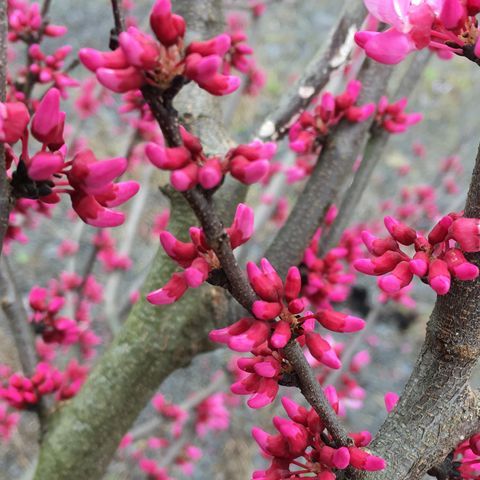
Redbud "Tennessee Pink"
Cercis Canadenis "Tennessee Pink"
The “Tennessee Pink” cultivar of the Eastern Redbud, or Cercis Canadensis, is different in several ways from the species. “Tennessee Pink” Redbud produces red flowers in the beginning stage that open to a clear pink instead of the normal purple-pink color. Like the species, these flowers bloom for two to three weeks in March and April before the foliage emerges.
The fall color is yellow, in contrast to the yellow-green of the rest of the species. The fruits, which are flattened legumes 2 or 3 inches long, mature in early autumn. “Tennessee Pink” Redbuds are also slightly smaller trees than the species Eastern Redbud, growing 15 to 20 feet tall with an equal-sized spread.
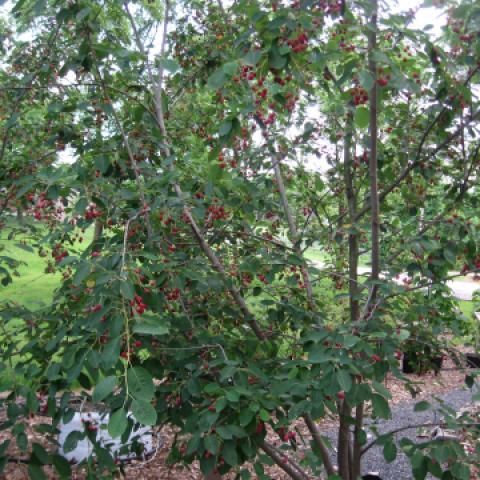
Serviceberry
Amelanchier X Grandiflora "Autumn Brilliance"
A four-season ornamental, Serviceberry or Amelanchier X Grandiflora, kicks off the growing season with a brief but showy display of pure white flowers in April. The attractive summer foliage, along with the tasty fruit, appears in June. The sometimes common name of Juneberry for this plant refers to this fact. The taste of the berries resembles blueberries, and they may be used in jams, jellies, and pies.
The fall color is a spectacular display of orange, red, or a combination of the two and is effective for up to two weeks. The striated bark and branching structure lend winter interest. Serviceberry thrives in partial shade, growing 15 to 25 feet tall with an equal spread. Early pruning to develop structure is beneficial for both the health and aesthetic beauty of the plant. This tree is available in both clump and single-stem forms.
The ornamental attributes are most effective when combined with other plants or backgrounds such as the following:
- An evergreen background to accent spring flowers and autumn color, with White Pines being an excellent choice
- Broadleaf evergreens such as Moonglow Magnolia
- 3Rugged-structured trees such as Burr Oak
- Light-colored masonry background to accent the structure
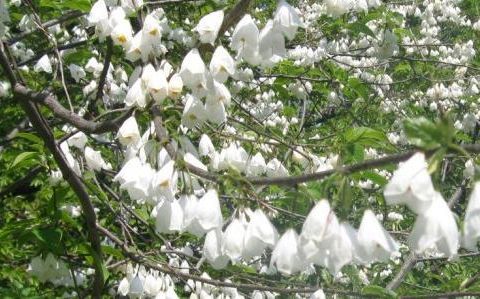
Silverbell
Halesia Carolina
Silverbell's bark is attractive, the fall color pleasing, and the summer foliage sensational, but the lovely, bell-shaped flowers trump all the other ornamental features on this under-used native tree. Flowers persist on the Silverbell, or Halesia Carolina, for 10 days or more, and even after the blossoms fall, they form a beautiful carpet on the ground below.
Native to the Piedmont and southern Appalachian Mountains of the southeastern United States, Silverbell makes a fine understory plant with its tolerance for semi-shade, but Silverbell can flourish in full sun as well if adequate soil conditions and moisture levels are present. It prefers well-drained, acidic soils. Remarkably trouble-free, Silverbell will give you few instances of disease problems although chlorosis is a possibility if the soil pH does become too high. It is a small tree, maturing at 25 to 30 feet with a similarly sized spread. The profile is usually rounded and low-branched and sometimes features several trunks.
Silverbell is one of our favorite small trees at Woodlawn LLC. If you place it against a lawn background, you will be able to enjoy both the spring flowers, which are most effective in front of a green background, and the informal growth habit and winter fruits, which are highlighted by a snow-covered landscape. Silverbell performs very well as a naturalizing plant at the edge of a woodland where the woods provide a dark background for spring floral contrast.
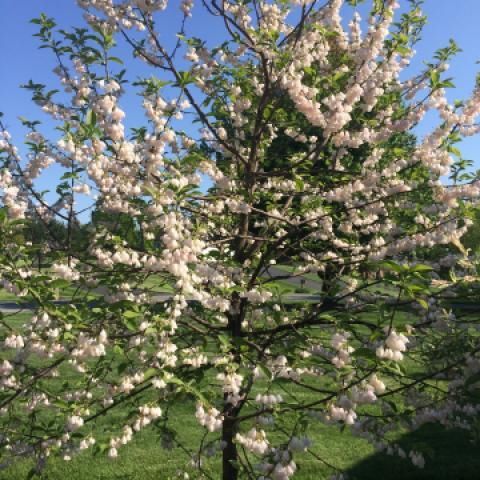
Silverbell (Pink)
Halesia Monticola "Rosea"
Pink Silverbell, or Halesia Monticola “Rosea,” is a delicate spring beauty with an intoxicating look! The bell-shaped blooms are the primary ornamental feature of this medium-sized tree, native to the Appalachian Mountains of Tennessee, North Carolina, and Georgia. The Pink Silverbell is a fine-looking plant the rest of the year as well with its lush summer foliage and attractive winter fruits. Silverbells are remarkably trouble-free with almost no insect or disease problems. The structure of this cultivar tends to be more well-mannered and uniform when contrasted with the White Silverbell. It also requires much less early pruning to produce a symmetrical form. Pink Silverbells typically grow 20 to 40 feet tall with a slightly smaller spread.
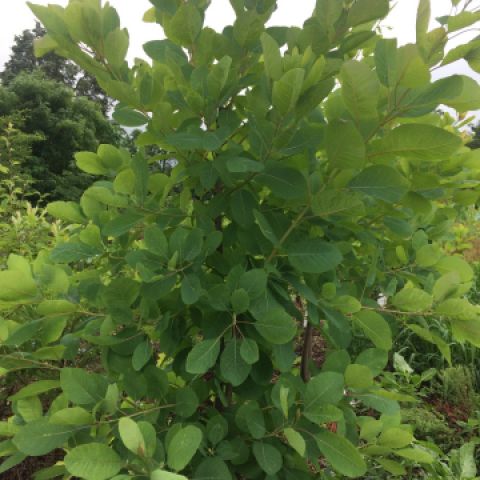
Smoketree (American)
Cotinus Obovatus
American Smoketree, or Cotinus Obovatus, is an ornamental plant in its own right. A tough tree, it grows naturally in rocky outcroppings in the lower Midwest. The flowers are insignificant, but the billowy hairs attached to the elongated stalks of the spent flower clusters turn a smoky, purplish-pink in midsummer, giving the tree a most unusual and attractive appearance. This floral effect is on show for weeks. The soft-green foliage turns a pleasing mid-green in late summer. The American Smoketree exhibits excellent fall color. Actually, it produces some of the best fall colors of our native trees and shrubs with corky bark. It shows a toleration for high pH soils and difficult growing conditions. So why isn't this tree used more? Most plantsman are indifferent and the public is naïve. This tough little performer is one of those horticultural secrets. Plant one and enjoy. It grows 20 to 30 feet tall with an equal-sized spread.
Many gardeners are familiar with the inferior European Smokebushes with their purple and blue leaves, but the gentle, lime-colored foliage of the American Smoketree is easily superior. Show off the foliage by planting it among and in front of plants with darker-colored foliage. Flowering on the Smoketree occurs in mid-summer or late-summer. Use it to liven up the tired, season-worn landscape. American Smoketree has a medium texture that allows it to blend with a wide variety of other plants.

Sourwood
Oxydendrum Arboreum
The Sourwood, or Oxydendron Arboreum, is an understory tree, native to the southern Appalachian Mountains, where it is perhaps most commonly found growing on rocky, wooded slopes along with other heath family members like azaleas and rhododendrons. The drooping, cream-colored summer flowers are, however, unique to this sole member of its genus. The brilliant red fall color is as reliable as it is outstanding. Sourwood puts on every fall a display unsurpassed by any other native small tree! The bark is also interesting, exhibiting a corky texture somewhat similar to the Black Tupelo's but more pronounced. This tree requires well-drained, acidic soil and grows 15 to 30 feet high and 10 to 12 feet wide.

Tupelo
Nyssa Sylvatica
They're tough and durable. They can thrive in poorly drained soils as well as dry uplands. Soil compaction? Not a problem. Black Tupelo is not only a dogged performer but also a beautiful addition to almost any landscape. The most outstanding feature is the foliage: glossy, dark green in the summer changing to a stunning array of orange and red hues in the fall. Another attractive feature is the horizontal branching which, with a little creative placement, can make an appealing statement in the dormant season.
The longevity of Black Tupelos is remarkable. There are living specimens that are hundreds of years old.
Overall, Black Tupelo is a great tree in its own right, but cultivars have been gradually developed in the last 20 years, producing even more trees that lend the perfect touch. Even so, if you're looking for a natural and informal addition to your garden, the species is still best. The cultivars work best in formal landscapes such as specimens and when planted along walkways.
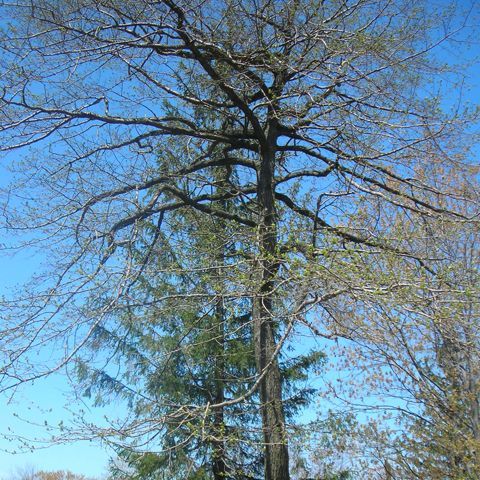
Tupelo (Black)
Nyssa Sylvatica
Black Tupelo, sometimes known as Sour Gum, is a very refined native when properly placed. The small, greenish-white flowers in springtime give way to oval fruits that are 0.5 inches long and technically edible although quite sour (hence the name of Sour Gum). The fruits ripen to a dark blue and are very attractive to birds and wildlife. The foliage, glossy in the summer, exhibits spectacular yellows, oranges, or reds in the autumn. This tree usually maintains a strong central leader with horizontal branching. A dogged performer, it can handle a wide range of growing conditions. Black Tupelo, or Nyssa Sylvatica, is a long-living tree. Individuals several centuries old exist today. As mentioned, Black Tupelo can be situated in a wide variety of locations in the landscape. The horizontal branching is often used to stabilize solid backgrounds. Slow-growing, Black Tupelo usually reaches 40 to 50 feet in height with a spread of 20 to 20 feet. Purchase one at Woodlawn LLC today and bequeath its beauty to future generations!
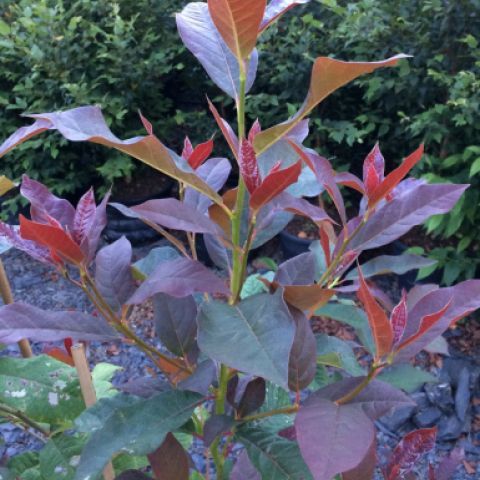
Tupelo (Black) "Wildfire"
Nyssa Sylvatica "Wildfire"
Black Tupelo is a beautiful native landscape tree known for its exceptional fall color. The cultivar Black Tupelo “Wildfire” offers an exciting addition with its reddish new growth adding splashing color to the summer landscape. Foliage matures to a rich, glossy green, resistant to fungal diseases. During the dormant season, the horizontal branches produce a layered outline. Hardy and resilient, Black Tupelo “Wildfire,” or Nyssa Sylvatica “Wildfire,” tolerates urban soil environments quite well provided the pH is not too high. The growth rate is slow to medium. Black Tupelo grows 40 to 50 feet high and 20 to 30 feet wide.
To showcase Wildfire’s new growth, avoid planting the tree among or in front of dark-colored objects or trees. American Smoketree, with its lime-green foliage, makes a wonderful companion plant. With its strong, horizontal branching, Black Tupelo's structure will serve as a visual anchor in the garden. The structure makes an excellent silhouette in the dormant season so, if possible, plant where the outline is visible above the horizon. This also allows the blue sky to serve as a perfect background for the brilliant fall color.

Tupelo (Black) "Red Rage"
Nyssa Sylvatica "Red Rage"
Black Tupelo “Red Rage” is at home in almost any landscape. Like all Black Tupelos, it has a strong central leader with horizontal branching that rarely sustains storm damage. A dogged performer, it can handle a wide range of growing conditions from poorly drained soil to dry. Black Tupelos are also long-lived trees with centuries-old individuals to prove it. Black Tupelo “Red Rage” is an improved cultivar with clean, glossy summer foliage and brilliant red fall color.
Growing 40 to 50 feet high with a spread of 20 to 30 feet, Black Tupelos can be situated in a wide variety of locations in the landscape. The horizontal branching is valuable for stabilizing solid backgrounds.
"And out of the ground made the Lord God to grow every tree that is pleasant to the sight..."
We bought a Carolina Silverbell and a Hornbeam, and they planted both. They are thriving, and the Silverbell has been flowering for weeks.
- James C. via Google
Learn More About Woodlawn LLC
Located at 3171 Ritner Hwy, Newville, PA. Woodlawn LLC specializes in trees, tough trees, native trees, and tree care services. Certified arborist. 30+ years of experience. Competitive prices. Call now.
serving Area
Newville, PA
New Paragraph


Share On: